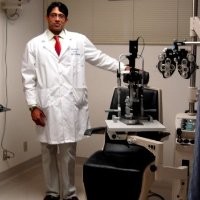Navigating the world of eyeglass prescriptions can be a daunting task, especially when the terminology seems complex. Whether you’re a long-time glasses wearer or a newcomer, it’s beneficial to understand your eye prescription. This knowledge allows you to select the most suitable glasses for your unique needs. Let’s simplify the jargon and make sense of the abbreviations commonly found on an eye prescription.
Abbreviations on an Eye Prescription
You’ve got your prescription in hand, but what do these terms signify? Here’s a breakdown.
OD: This abbreviation is derived from the Latin term “oculus dexter,” signifying the right eye.
OS: This represents the left eye, stemming from the Latin phrase “oculus sinister.”
OU: Different from the previous two, OU pertains to both eyes and originates from the Latin term “oculus uterque.”
NV: Standing for near vision, NV refers to the ability to discern objects at close range.
DV: This denotes distant vision or the capability to perceive objects from afar.
PD: Pupillary Distance (PD) is the measurement of the distance between your pupils, a crucial factor in properly fitting your glasses.
Numbers: These represent the diopters or lens power necessary to correct your eyes’ refractive error.
Negative Numbers: A negative number on your prescription indicates myopia, requiring lenses that sharpen distance vision.
Positive Number: This signifies hyperopia, which necessitates lenses to enhance your near vision.
Understanding More Eye Prescription Terms
Your eye prescription chart may also include other terms, which can be somewhat confusing. Here’s a simple explanation.
Sphere (SPH): This indicates whether you are nearsighted (-) or farsighted (+).
Cylinder (CYL): This term relates to the correction of astigmatism. An empty field here means either no astigmatism or a very minor one.
Axis: This term pinpoints where the cylinder power should be applied to correct astigmatism, a common eye condition causing blurred vision due to irregularly shaped cornea or lens.
Add: This refers to the additional magnifying power needed for reading as you grow older. It ranges from +0.75 to +3.00 D and applies to both eyes.
Prism: In some cases, prescriptions may include a prism measurement to address eye alignment issues. Terms like BU = base up, BD = base down, BI = base in, and BO = base out may be used.
These figures are usually reported in quarter-diopter increments as decimal numbers. However, axis values merely denote the position and do not signify any actual lens power.
Changes in Your Eyeglass Prescription
Significant shifts in your vision prescription over time are uncommon and warrant further investigation unless they are due to treatment or injury. Minor, gradual changes, however, can occur, especially as you age. For instance, you may develop presbyopia (usually in your forties), necessitating reading glasses or progressive lenses. An annual eye examination is recommended even if there are no changes in your vision or any concerning symptoms.
Differences in Eyeglass and Contact Lens Prescriptions
Contact lens prescriptions differ from those for glasses. Contact lenses rest directly on your eye’s surface and must match your eye’s curvature. This prescription includes measurements for the base curve and the diameter. The base curve is commonly a number between 8 and 10, corresponding to your eye’s shape, while the diameter ranges from 13 to 15 millimeters. A contact lens prescription also includes the lens brand and type, along with the expiry date. It should be updated annually to account for vision changes and ensure an optimal fit.
In conclusion, understanding your eyeglass prescription and the associated terms, from OD and OS to NV, empowers you to make informed decisions about the best glasses for your visual needs. With this knowledge, you can confidently and clearly see the world around you.


Comments are closed for this post.